CAA News Today
Meet the Meiss Fund Recipients for Fall 2020
posted by Allison Walters — January 25, 2021
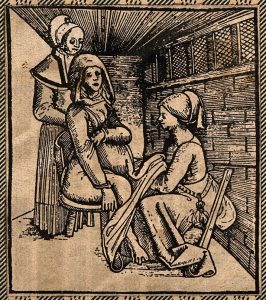
A woman seated on a obstetrical chair giving birth aided by a midwife who works beneath her skirts. Woodcut.
MEET THE GRANTEES
Twice a year, CAA awards grants through the Millard Meiss Publication Fund to support book-length scholarly manuscripts in the history of art, visual studies, and related subjects that have been accepted by a publisher on their merits, but cannot be published in the most desirable form without a subsidy.
Thanks to the generous bequest of the late Prof. Millard Meiss, CAA began awarding these publishing grants in 1975.
The Millard Meiss Publication Fund grantees for Fall 2020 are:
- Cammy Brothers, Giuliano da Sangallo and the Ruins of Rome, Princeton University Press
- Lindsay Caplan, Programmed Art: Freedom, Control, and Computation in 1960s Italy, University of Minnesota Press
- Margaret Graves and Alex Dika Seggerman, Making Modernity in the Islamic Mediterranean, Indiana University Press
- Diana Greenwald, Painting by Numbers: Data-Driven Histories of Nineteenth Century Art, Princeton University Press
- Subhashini Kaligotla, Shiva’s Waterfront Temples: Self and Space in Medieval India, Yale University Press
- Sigrid Lien, Colonial Legacies, Decolonial Activism: Indigenous Photographs Revisited, University of British Columbia Press
- Elizabeth Perrill, Burnished: Zulu Ceramics Between Rural and Urban South Africa , Indiana University Press
- Stephanie Sparling Williams, Speaking Out of Turn: Lorraine O’Grady and the Art of Language, University of California Press
- Rebecca Whiteley, Birth Figures: Early Modern Prints and the Pregnant Body, University of Chicago Press
Read a list of all recipients of the Millard Meiss Publication Fund from 1975 to the present. The list is alphabetized by author’s last name and includes book titles and publishers.
BACKGROUND
Books eligible for a Meiss grant must currently be under contract with a publisher and be on a subject in the arts or art history. The deadlines for the receipt of applications are March 15 and September 15 of each year. Please review the Application Guidelines and the Application Process, Schedule, and Checklist for complete instructions.
CONTACT
Questions? Please contact Cali Buckley, Grants and Special Programs Manager, at cbuckley@collegeart.org.
Art Journal Winter 2020 Video Abstract, “Now’s the Time,” a Message from Jordana Moore Saggese
posted by Allison Walters — January 13, 2021
Video Abstract – Now’s the Time from Taylor & Francis on Vimeo.
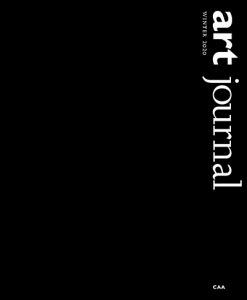
Art Journal Winter 2020
Usually when I sit down to write the introduction to a forthcoming issue of Art Journal, I am pleasantly surprised to find intrinsicconnections between the work we do as artists, historians, and critics. In past issues we have learned to look differently, to take matters personally, and to think in the present tense. And somehow we have done all this against an evolving (and often terrifying) backdrop of political, economic, social, environmental, and health crises. As I write this essay in early October, the pressure of reality—including the upcoming US presidential election—has made it difficult for many of us to orient ourselves to our research and creative practices. But, at the same time, the urgency of this work has never seemed more real.
In 2015 Toni Morrison wrote an essay for The Nation that, in part, framed her own feelings of helplessness in times of political and social turmoil. These days I find myself turning to these words again and again:
This is precisely the time when artists go to work. There is no time for despair, no place for self-pity, no need for silence, no room for fear. We speak, we write, we do language. That is how civilizations heal.
I know the world is bruised and bleeding, and though it is important not to ignore its pain, it is also critical to refuse to succumb to its malevolence. Like failure, chaos contains information that can lead to knowledge—even wisdom. Like art.
And so we must keep writing, making, and teaching. We must try to cultivate wisdom instead of succumbing to despair.
With Morrison’s mandate in mind I introduce this special edition of Art Journal: an issue centered on Blackness. The ideas represented here have been carefully brought into an intentional conversation around the experiences, expressions, and theorizations of Blackness. We have artist projects by two Black women—Allison Janae Hamilton and Chanell Stone—and all the book and exhibition reviews center on works by and about Black artists (thanks to the tireless effort of our reviews editor, Mechtild Widrich). The feature essays reorient our attention to artists—Mark Bradford, Samuel Levi Jones, Glenn Ligon, Howardena Pindell, Jack Whitten—who explore the histories, sensations, and consequences of Blackness in their work.
As argued so compellingly by Leigh Raiford in her essay, “Our work is to recognize how white supremacy functions as a way of seeing that any person of any race or positionally can work to undo.” I hope that in editing the first issue of Art Journal to focus exclusively on Blackness, I have provided a counterweight to the ideology of white supremacy that has infected our political landscape in the United States and (in so many ways) the history of art itself. As we mourn the murders of Ahmaud Arbery, Breonna Taylor, and George Floyd and the deaths of thousands from COVID-19, let us also work toward the new future and find meaning in the chaos.
– Jordana Moore Saggese
The entire issue of Art Journal Winter 2020 is free to read through March 31, 2021.
In Memoriam: Roland Reiss
posted by Allison Walters — January 12, 2021
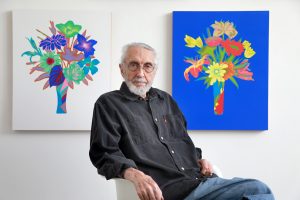
Roland Reiss in front of by Unrepentant Flowers (April 2018), photo by Eric Minh Swenson
We are deeply saddened that Roland Reiss, whose practice spanned Abstract Expressionism, the plastic arts, and representational painting, died on December 13 in Los Angeles at the age of ninety-one.
Jorin Bossen has spoken on the life and career of Roland Reiss:
“Roland saw everything through the lens of art. Even in his last year he produced stacks of drawings each week examining the simple proposition of a circle positioned next to a square. This investigation of thought and possibility extended into the way that he undertook teaching. Teaching was an interactive process—an exchange of ideas. He knew how to point his students in the general direction we needed to be heading. Through new techniques, unfamiliar materials and mediums, seemly-unrelated exercises, and personal chats students often found ourselves in new and unexpected artistic territory. One that we didn’t know existed but filled us with hope, fear, and excitement. For Roland teaching was art.”
International News: The Van Abbemuseum in the Netherlands Explores the Legacies of Colonialism in a Solo Exhibition by Victor Sonna
posted by Allison Walters — January 08, 2021
The following article was written in response to a call for submissions by CAA’s International Committee. It is by Ilaria Jessie Obata, an art historian and curator currently completing an MA in Curating Art and Cultures at the University of Amsterdam.
Victor Sonna’s first solo exhibition, 1525, which opened at the Van Abbemuseum in Eindhoven in July 2020, tells a multilayered story of personal introspection and shared colonial legacies. This collaboration between the artist and the museum is among the most recent exhibitions that fall under the mission scope of Musea Bekennen Kleur (Museums Confess Color), a contemporary platform established in Amsterdam in March 2020, in which “museums take accountability and responsibility through ongoing conversations about achieving diverse and inclusive institutional settings” (Musea Bekennen Kleur, https://museabekennenkleur.nl/).
The Van Abbemuseum, a participant in this project, is also one of the first museums in the Netherlands to embark upon a steady process of decolonizing its exhibitions and collections. This institutional decision was further marked by the Van Abbemuseum’s 2007 exhibition, Be(com)ing Dutch, in which participating artists Anette Kraus and Petra Bauer criticized racialized images of Zwarte Piet (Black Pete), which perpetuate the use of black face for the Sinterklass holiday (Saint Nicholas). The museum encountered severe backlash from the far-right party in the Netherlands for its criticism of the Dutch holiday, which further exposed this contested discussion within the country as whole. This response exemplified the need to continue the process of decolonizing cultural and educational platforms that perpetuate racial stereotyping. Therefore, Sonna’s solo exhibition builds upon the museum’s desire for institutional accountability regarding the Netherland’s recent past and its involvement with the trans-Atlantic slave trade. Sonna and the Van Abbemuseum decided to organize an exhibition with a dynamic narrative that would prompt discussion about contemporary colonial legacies. Working together, Sonna, Van Abbe director Charles Esche, curator Steven ten Thije, and guest curator Hannah Vollam, designed and curated an exhibition that presented Sonna’s research from multiple perspectives.
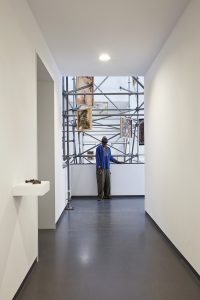
Figure 1. Victor Sonna in his 1525 exhibition at the Van Abbemuseum, 2020. Photo: Ronald Smits
Born in 1977, Victor Sonna is a visual artist who moved to the Netherlands at age nineteen from Yaoundé, Cameroon. Having studied at the Design Academy in Eindhoven and then at the AKV | St. Joost in Den Bosch, Sonna is based in Eindhoven and works in various mediums. His Van Abbemuseum exhibition includes three installations of tapestries, prints, and audio-visual material. The exhibition narrative started with his purchase of a pair of chains that once belonged to an enslaved person in New Orleans. The number 152 was engraved on these chains and thus remains the focal point for the exhibition title, 1525 (Fig. 1). Sonna’s installations regularly refer to the commoditization of human life under slavery, or rather “…the treatment of persons as property or, in some kindred definitions, as objects… when the individual is stripped of his previous social identity and becomes a non-person, indeed an object and an actual or potential commodity” (Igor Kopytoff, “The Cultural Biography of Things: Commoditization as Process,” in The Social Life of Things: Commodities in Cultural Perspective, p. 65). Sonna’s purchase led to his own research on the socio-historical impact of colonial exploitation, which constructed and perpetuated the commodification of human life for Western imperial profit.
His audio-visual works, which contextualize and document the slave trade in Ghana, are shown in six separate film installations in the exhibition. Sonna visually captured the external and internal space of Fort Elmina, a former slave trading post that was seized and consolidated by the Dutch in 1637. He documents remembrances of the trans-Atlantic slave trade, which have remained imprinted upon the walls of the fort and linger within the smell of the dungeons. The fort “plays a central role within the exhibition since the title,1525, also corresponds to the year marking the departure of the first slave ships from the West African coast to the Caribbean islands”(Harmen van Dijk, TrouwNL, 18 July 2020, translated from Dutch by the author). Sonna used this historical research to better understand the dehumanizing effects of the trans-Atlantic slave trade that turned enslaved African individuals into commodities, and led to a specific form of merchandising the colonial: distinguishing people as objects and as lesser than human.
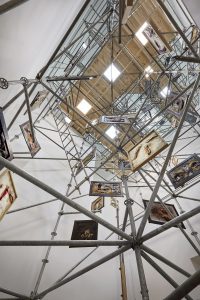
Figure 2. Victor Sonna, Tower of Babel, 2020, Van Abbemuseum. Photo: Ronald Smits
The accompanying installations showcase Sonna’s training as a visual artist as he meshes together the mediums of sculpture, metalwork and tapestry through the jaw-dropping 82-foot-high steam beam tower, from which his framed tapestries hang within the inner spire of the museum. This massive installation, titled the Tower of Babel (Fig. 2), contains the 152 tapestries that require multi-angled viewings because both sides of the frames are packed with layers of overlapping materials, from glued cane sugar to metallic nails and coins. Sonna gathered 152 European Gobelins tapestries, made between the eighteenth and twentieth century, which comprise his series Bleach and Dust, Sugar and Rubber and Maps. However, Sonna wanted to deconstruct the singular perception of these tapestries as representing “the history and prosperity of Europe” (Harmen van Dijk, TrouwNL, 18 July 2020, translated from Dutch by the author), by exposing the forms of exploitative slave labor used to extract materials such as sugar and rubber, which are imbedded and glued onto the surface of the tapestry. On Sonna’s website he states that this series approaches the “layering and displaying of connected histories that have been etched, trapped and layered in the earth” (Victor Sonna, http://victorsonna.com/site/news.php ).
Sonna presses different sculptural materials into the tapestries, creating multiple reliefs on their surfaces (Figs. 3,4,5). He “traps” metallic objects: coins, metal chains, and nails along with Kente cloth from Ghana that has been rolled up and sewn into the tapestries, and granulated cane sugar glued around the edges. He purposefully imbeds these materials into the textural DNA of the tapestry and locks each object inside it. The reliefs pushing out of the tapestry juxtapose the Gobelins framed surface with the visual effects of these contrasting materials, making us look again. The materiality of such commodities is weighed down by the history of their production, one fueled by the violence and death that characterizes the slave trade and its plantations. The artist’s desire to etch and trap together seemingly disparate materials creates a correlation between a shared European history of colonial exploitation and the creation of racial difference.

Figures 3, 4, 5. Victor Sonna, 2020, Van Abbemuseum. Photo: Ronald Smits
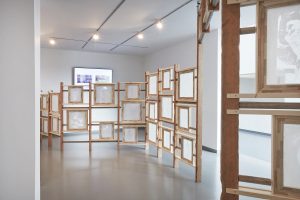
Figure 6. Victor Sonna, Wall of Reconciliation, 2020, Van Abbemuseum. Photo: Ronald Smits
Lastly, a striking section of this exhibition required two visitors to stand in front of one another, separated by a series of fifty-two silkscreen frames titled the Wall of Reconciliation (Fig. 6). The term “reconciliation” connotes Sonna’s desire to ensure that the printed image reconciled two opposing views. Every silkscreen required a dark backdrop in order to see the printed image; it is only visible if two visitors are standing on opposites sides of the same screen. Thus, the two viewers on opposite sides see the same explicit images of violence that are part of a series of drawings depicting slavery in Suriname, a Dutch colony that gained independence only in 1975. In Figure 7, the image depicts a young boy holding a rake, signifying the effects of enforced labor during the formative years of a child’s life and how it can mold a perception of the self that is intrinsically tied to an object of labor. Henceforth, each of these installations emphasized Sonna’s desire to deconstruct a biased and unilateral frame of reference.
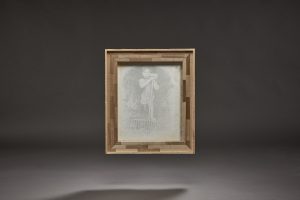
Figure 7. Victor Sonna, Wall of Reconciliation, 2020, Van Abbemuseum. Photo: Ronald Smits
1525, which has received acclaimed reviews in the Dutch press, is on display at the Van Abbemuseum until May 2021. Writers have collectively applauded the museum’s commitment to showcasing this stirring and historically fueled narrative. The Van Abbemuseum will continue to produce related public programming that is both accessible and reflective of its mission to highlight the legacies of Western colonialism in a Northern European context.


